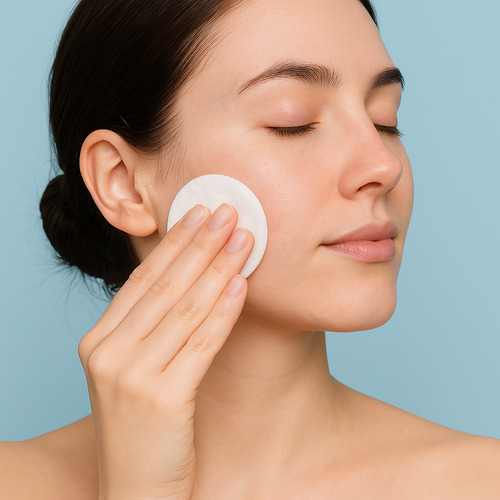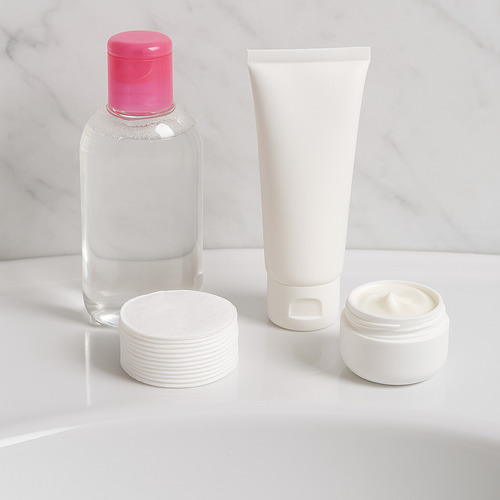Just when you think you know exactly how to wash your face properly, TikTok tips can make you doubt even this seemingly simple step of self-care. And when you add makeup removal into the mix, the number of conflicting recommendations grows even further. While this step may not seem the most “glamorous,” properly removing makeup and cleansing your face is crucial for maintaining healthy skin.
Experts emphasize that there is a right and a wrong way to remove makeup, and mistakes at this stage can have long-term consequences. In this article, we share professional dermatologist advice on how to care for your skin effectively and safely when removing makeup.
Why Makeup Removal Is So Important
A consistent evening skincare routine is extremely important, and a key part of it is thoroughly removing makeup. This not only supports skin renewal but also prevents clogged pores, which can lead to acne and blackheads.
Clogged pores are just one of the potential issues. Makeup traps dirt, dust, and other environmental pollutants on the skin’s surface. Over time, this leads to skin overload, uneven texture, premature aging, and dryness if makeup is not removed properly.
Additionally, leftover makeup prevents nighttime skincare products from fully penetrating the skin, reducing their effectiveness. Simply put: if makeup isn’t completely removed, the rest of your skincare routine loses its purpose.
Are makeup-removing wipes effective?
When it comes to removing makeup, wipes often seem like a convenient solution. In a pinch, they are indeed better than nothing, but experts strongly advise against relying on them regularly. Wipes remove cosmetics less effectively, and the vigorous rubbing required for long-lasting products can irritate the skin.
Additionally, many wipes contain fragrances and other hidden ingredients that can increase skin sensitivity.
Many wipes also contain acids or alcohol, which can damage the skin’s protective barrier and dry it out. Simply put, don’t risk your skin’s health for the sake of these wipes when micellar water is just as convenient but much safer.
The Most Effective Way to Remove Makeup Before Bed: Step by Step
1. Wash your hands thoroughly before starting
Dermatologists strongly recommend thoroughly washing your hands before removing makeup and, more importantly, before touching your face. This helps prevent the transfer of dirt and bacteria to your skin, reducing the risk of irritation and breakouts.
2. Remove makeup from your face
When it comes to makeup removal, there are two proven and effective methods: oil-based cleansers (or cleansing balms) and micellar water. Both options remove makeup thoroughly while gently caring for the skin and preventing dryness. Micellar water is especially suitable for sensitive and acne-prone skin, while oil-based cleansers work best on heavy and full-coverage makeup. Many people alternate these products depending on the skin’s condition and specific daily needs.
3. How to use micellar water
If you’re using micellar water, soak a cotton pad or reusable cloth with it and gently wipe off the makeup. Pay special attention to the hairline, eyelids, and jawline to ensure the product completely removes cosmetics. There is no need to rinse off micellar water after use.
4. How to use an oil-based cleanser
If you choose an oil-based product, apply a few drops (or a small amount) to dry skin, including the eyelids, and gently spread it over the entire face. Work with the product calmly for about a minute — the makeup will start to dissolve. Then rinse with water: this activates the oil emulsion, making it easy to remove leftover makeup and impurities.
5. Remove makeup from eyes and lips
Removing long-wear eye and lip makeup may require a separate product. For waterproof mascara or eyeliner, apply a little cleansing oil or micellar water to a cotton pad, hold it gently on the eyes for 15–20 seconds, and then remove the makeup. This method also works well for long-lasting lipstick or lip tints. You can also use a specialized eye makeup remover, which is especially effective for waterproof and long-wear products.
Tip: If you have eyelash extensions, it is recommended to use products specifically designed for them. Regular cleansing oils or makeup removers can weaken the adhesive that holds the lashes, reducing their longevity.
6. Cleanse your face
While some debate the necessity of double cleansing, there is no doubt about its benefits when removing makeup. The first step — cleansing oil or micellar water — effectively removes decorative cosmetics, and the second step ensures complete skin cleansing.
Even after thorough makeup removal, small residues remain on the skin, making double cleansing particularly important. Afterward, apply a gentle facial cleanser suitable for your skin type. Massage it in circular motions for about 60 seconds, then rinse with warm water.
7. Post-makeup skincare
After removing makeup, it is especially important to care for your skin’s hydration and restoration. Start by applying a moisturizing essence or toner — these instantly replenish moisture and prepare the skin for active ingredients. Then continue your regular skincare routine, finishing the process with a nourishing cream for maximum effect.
Common Mistakes to Avoid
Although removing makeup may seem like a simple process, there are several common mistakes you should avoid.
- Rubbing the skin too hard: When removing makeup, avoid rubbing or stretching the skin. Be especially gentle around the delicate eye area — aggressive movements can cause irritation and contribute to premature wrinkles.
- Using harsh products: Makeup removers that are too harsh or unsuitable for your skin type — for example, alcohol-based products or strong cleansing gels — can lead to irritation, dryness, and increased skin sensitivity.
- Incomplete makeup removal: Residual makeup, especially in often overlooked areas such as the hairline, eyelids, and around the jawline, can clog pores and cause breakouts.
- Rubbing the skin too hard: When removing makeup, avoid rubbing or stretching the skin. Be especially gentle around the delicate eye area — aggressive movements can cause irritation and contribute to premature wrinkles.
- Using harsh products: Makeup removers that are too harsh or unsuitable for your skin type — for example, alcohol-based products or strong cleansing gels — can lead to irritation, dryness, and increased skin sensitivity.
- Incomplete makeup removal: Residual makeup, especially in often overlooked areas such as the hairline, eyelids, and around the jawline, can clog pores and cause breakouts.
- Skipping double cleansing: Double cleansing is an essential step for thoroughly removing a full face of makeup. This procedure is particularly important when using heavy or waterproof makeup, as a single cleanse may not be sufficient.
- Using dirty or overly abrasive tools: Washcloths and makeup sponges can become too abrasive with frequent use and may damage the skin. Additionally, dirty hands, cotton pads, towels, cloths, and other cleansing tools can transfer bacteria back onto the skin, causing inflammation, irritation, and worsening existing issues.
- Neglecting care for eyes and lips: It is important to carefully remove even the smallest traces of makeup from these areas, as leftover particles can cause irritation, dryness, or even infections.
⸻
Let’s be honest: rushing through makeup removal isn’t the best idea. This approach not only fails to properly cleanse your skin, but can also lead to clogged pores, breakouts, and reduce the effectiveness of the products you apply afterward.
We get it — after a long night, coming home at 1:50 a.m., the thought of a full skincare routine can feel like torture. But you don’t need to turn it into a spa ritual! If you’re completely exhausted, three simple steps are enough: wipe your face with micellar water, cleanse with a gentle face wash, and apply a rich moisturizer before bed.
Tip: Keep your micellar water, cotton pads, cleanser, and moisturizer right by the sink. When you come home, everything you need will be within reach — and you won’t even have to convince yourself to do it.


